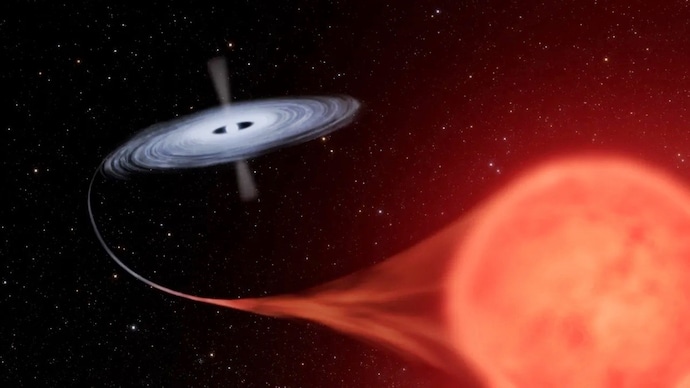The new observations reveal that the system has become hotter but paradoxically faded slightly in recent years.

This artist’s concept shows the nova system HM Sagittae (HM Sge), where a white dwarf star is pulling material from its red giant companion. (Photo: Nasa)
Astronomers have used new data from NASA's Hubble Space Telescope, the retired Stratospheric Observatory for Infrared Astronomy (SOFIA), and archival data to revisit the peculiar binary star system HM Sagittae (HM Sge) – 40 years after it underwent a bright and long-lived nova explosion.
In April-September 1975, HM Sge, a symbiotic star system comprising a white dwarf and a dust-producing giant star, grew 250 times brighter in an unusual nova event. Unlike typical novae that fade quickly, HM Sge has maintained its luminosity for decades, puzzling astronomers.
The new observations reveal that the system has become hotter but paradoxically faded slightly in recent years. The 2021 ultraviolet data from Hubble showed a strong emission line of highly ionized magnesium, indicating the white dwarf and accretion disk temperature increased from less than 400,000°F in 1989 to over 450,000°F now.
"When I first saw the new data, I went – 'wow this is what Hubble UV spectroscopy can do!' – I mean it's spectacular, really spectacular," said Ravi Sankrit of the Space Telescope Science Institute.
Using SOFIA data, the team detected water, gas, and dust flowing around the system at speeds of around 18 miles per second, suspected to be the speed of the accretion disk. The gas bridge connecting the stars likely spans 2 billion miles.
Infrared data showed the giant star returned to normal dust production within a couple of years after the explosion but has dimmed recently, adding another puzzle.
"Symbiotic stars like HM Sge are rare in our galaxy, and witnessing a nova-like explosion is even rarer. This unique event is a treasure for astrophysicists spanning decades," said Steven Goldman of the Space Telescope Science Institute.
The team collaborates with amateur astronomers worldwide who monitor HM Sge, revealing changes unseen since its 1975 outburst. Initial results were published in the Astrophysical Journal, and further UV spectroscopy research is being presented at the 244th American Astronomical Society meeting.
Published By:
Sibu Kumar Tripathi
Published On:
Jun 12, 2024













 English (US) ·
English (US) ·